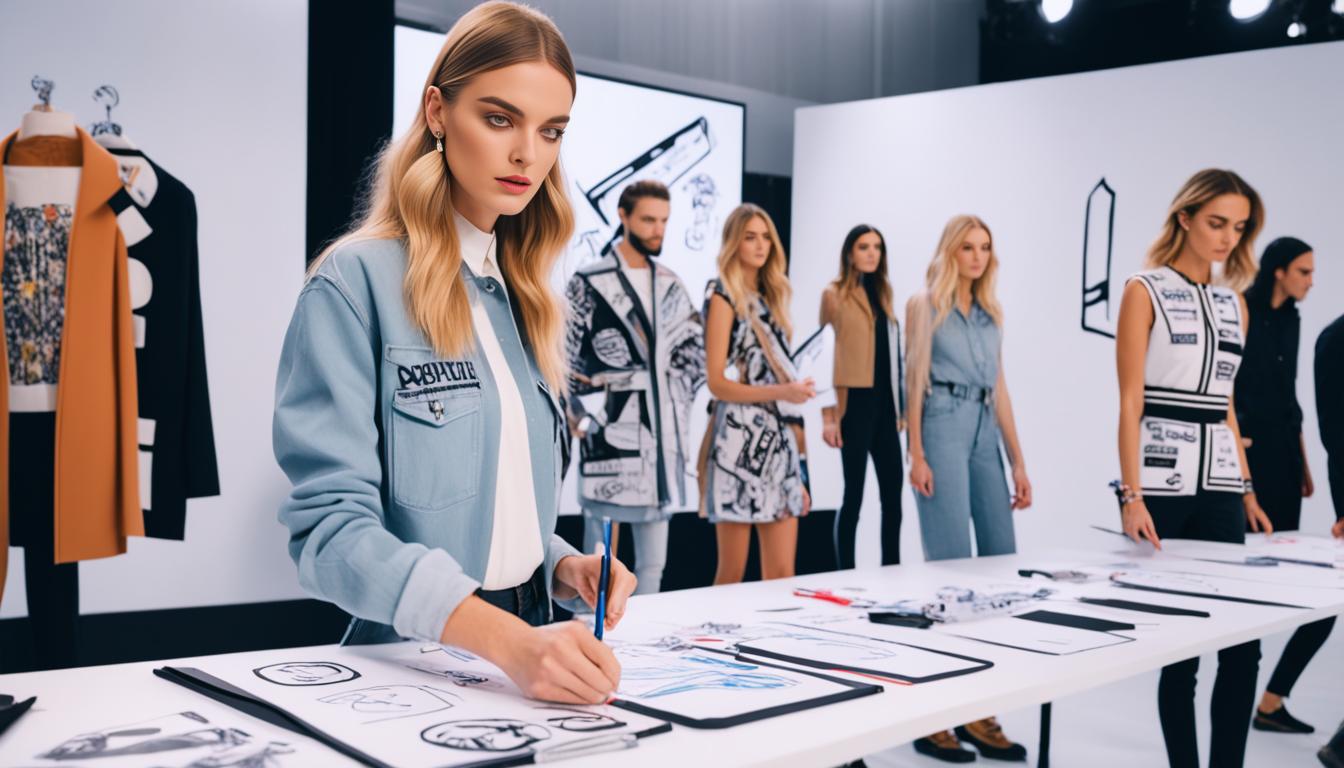Collaborating with fashion designers and brands opens up exciting opportunities in the dynamic fashion industry. By joining forces with like-minded partners, we can expand our brand’s audience, enhance our visibility, and increase our credibility. Through strategic brand partnerships, we can create unique experiences for our customers and target new markets, driving growth and success.
Key Takeaways:
- Fashion collaborations offer valuable opportunities to expand our brand’s audience and reach new markets.
- Identify ideal partners by considering factors such as brand identity, target audience, and core values.
- Define clear objectives and expectations for the partnership, focusing on co-creation, cross-promotion, or resource-sharing.
- Craft a win-win proposition that highlights the benefits of collaboration for both parties.
- Plan, execute, and nurture relationships with our partners to ensure long-term success.
Identifying Ideal Partners
Before embarking on a brand partnership journey, it’s essential to have a clear vision of the brands you want to collaborate with. Finding the right partners is crucial for the success of your fashion brand. By considering factors such as brand identity, target audience, core values, and competitive edge, you can identify ideal partners who will complement and enhance your brand’s image.
When searching for potential partners, think about how a collaboration could benefit both parties involved. Look for brands that share similar values and have a style that complements yours, rather than those that compete or clash with your brand’s identity. For example, if you are a sustainable fashion brand, you might consider partnering with a natural beauty brand or a social impact organization that aligns with your mission.
Collaborating with designer labels can bring a new level of creativity and expertise to your fashion brand. Partnering with established designers allows you to tap into their unique aesthetics and craftsmanship, attracting a wider audience and gaining credibility in the industry.
“A successful partnership is not just about finding a brand that shares your values—it’s about finding the right fit that brings something extra to the table.”
When brainstorming fashion brand partnership ideas, focus on how the collaboration can enhance the customer experience. Consider co-creating limited-edition collections, hosting joint fashion shows or pop-up shops, or even collaborating on marketing campaigns. These initiatives can generate excitement among your target audience and create memorable experiences that differentiate your brand from competitors.
Ultimately, working with fashion designers and collaborating with designer labels can elevate your brand to new heights. By carefully selecting partners who align with your brand’s values and aesthetic, you can create innovative and mutually beneficial collaborations that drive growth and success.
Collaborating with Influential Designers
| Benefits of Collaboration | Examples |
|---|---|
| Access to unique design aesthetic | Collaborating with Coco Chanel for a luxury capsule collection |
| Increased brand visibility and credibility | Partnering with Alexander McQueen for a runway show during Fashion Week |
| Expanding customer base through designer’s fan following | Teaming up with Stella McCartney to reach a wider audience of sustainable fashion enthusiasts |
Defining Objectives and Expectations
Now that we have a list of potential partners, it’s time to define our objectives and set clear expectations for our fashion collaborations. This step is crucial to ensure that both parties are aligned and working towards the same goals.
Firstly, we need to determine the type of partnership we want. Do we want to co-create a product, cross-promote content, share resources, or collaborate on events? Each type of collaboration brings its own set of benefits and opportunities.
For example, if our brand specializes in sustainable fashion, partnering with a natural beauty brand to create a co-branded collection could reinforce our commitment to eco-friendly practices. On the other hand, collaborating with a popular influencer to cross-promote each other’s content can help us expand our reach and tap into new markets.
Next, we must have a clear vision of the outcomes we want to achieve through these collaborations. Are we aiming to increase brand awareness, drive more sales, or strengthen our positioning in the market? Defining our objectives will guide our decision-making process and help us measure the success of each collaboration.
As we move forward, it is essential to communicate our expectations with our potential partners. By clearly outlining what we hope to achieve, we can ensure that everyone is on the same page and working towards a common goal. This open communication fosters trust, collaboration, and ultimately leads to successful fashion brand partnerships.
Remember, fashion collaborations for brands are not only about achieving individual success but also about creating a mutually beneficial relationship. When both parties have a clear understanding of their objectives and expectations, they can work together harmoniously and achieve remarkable results.

Here are some key points to consider when defining objectives and expectations:
- Identify the type of partnership that aligns with your brand values and business goals.
- Have a clear vision of the outcomes you want to achieve through the collaboration.
- Communicate your expectations with your potential partners and ensure they are aligned.
- Establish mutual understandings to foster trust and collaboration.
Crafting a Win-Win Proposition
A successful brand partnership is all about mutual benefits. By crafting a win-win proposition, you can create a compelling case for collaboration that showcases the advantages for both parties involved. This not only increases the likelihood of securing fashion collaboration opportunities but also lays the foundation for long-lasting and fruitful fashion brand partnerships.
When developing your proposition, highlight how working together can help each other achieve your goals. Consider the following:
- Access to a wider audience: Offer your partner access to your fan base, allowing them to tap into a new customer segment and expand their reach. For example, if you have a strong online presence or a loyal customer base, share these valuable resources with your partner to enhance their visibility and customer acquisition efforts.
- Exposure to new market segments: Collaborating with a partner who targets a different market segment can open doors to new customers. By leveraging each other’s customer base, you can introduce your brand to a whole new group of potential customers who may be interested in your unique offerings.
- Increased brand awareness: Joint marketing activities can significantly amplify brand visibility and create buzz around your collaboration. By combining your marketing efforts, you can reach a larger audience and generate greater brand awareness for both parties involved.
“A win-win proposition not only offers value to your partner but also ensures that your brand’s objectives and interests are met.”
On the other hand, it is equally important to consider what you can gain from the collaboration. When crafting your proposition, think about:
- A share of revenue: If your collaboration involves the creation and sale of a co-branded product, consider negotiating a fair distribution of profits to ensure that your efforts are adequately compensated.
- A referral fee: If your partnership involves referring customers to each other’s businesses, you can request a referral fee for each successful conversion. This incentivizes both parties to actively promote each other’s offerings.
- A testimonial: A positive testimonial or endorsement from your partner can significantly enhance your brand image and credibility. Requesting a testimonial can be mutually beneficial, as it provides social proof for your brand while also helping to establish your partner’s authority in their industry.
By offering valuable resources and requesting fair compensation, you can create a mutually beneficial proposition that aligns with your brand collaboration strategies and maximizes the potential of your fashion brand partnerships.
Planning, Execution, and Nurturing Relationships
Once you’ve reached an agreement with your fashion designer partner or brand, it’s time to put your plan into action. Planning and executing your collaboration strategy is key to a successful partnership. Consider various activities such as creating joint marketing campaigns, designing co-branded products, hosting co-sponsored events, or launching joint giveaways. These efforts will help you maximize your brand exposure, reach new audiences, and create a buzz around your collaboration.
Coordination and alignment with your partner are crucial throughout the process. Regular communication and collaboration will ensure that both parties are on the same page and working towards shared objectives. By working closely together, you can leverage each other’s strengths, resources, and expertise to create impactful and memorable experiences for your customers.
Measuring the results of your collaboration is essential to assess its effectiveness. Keep track of key metrics such as website traffic, engagement, sales, and customer feedback. Analyzing this data will help you understand the impact of your partnership and make informed decisions for future collaborations.
Remember, maintaining the relationship with your partner is just as important as the initial collaboration. Show gratitude by thanking your partner for their contribution and support throughout the process. Share feedback on the collaboration’s outcomes and discuss areas for improvement. Additionally, don’t hesitate to explore future partnership opportunities with your fashion designer or brand. Building long-term relationships can lead to more successful collaborations and continued growth for your brand.
FAQ
What are the benefits of partnering with fashion designers and brands?
Partnering with fashion designers and brands can help expand your brand’s audience, visibility, and credibility. It allows you to create unique experiences for your customers and reach new markets.
How do I identify the ideal partners for collaboration?
When identifying potential partners, consider factors such as brand identity, target audience, core values, and competitive edge. Look for brands that complement and enhance these aspects, rather than compete or clash with them.
How do I define my objectives and expectations for a brand partnership?
Determine the type of partnership you want and the goals you hope to achieve. Decide whether you want to co-create a product, cross-promote content, share resources, or collaborate on events. It is important to have a clear vision of the outcomes and benefits of the partnership and communicate them with your partner.
How do I create a win-win proposition for a brand partnership?
Craft a compelling proposition that highlights the advantages of working together and how you can help each other achieve your goals. Offer your partner access to your fan base, exposure to new market segments, or increased brand awareness. In return, consider requesting a share of revenue, a referral fee, or a testimonial.
How do I plan, execute, and nurture a brand partnership?
After agreeing on the terms and conditions of the partnership, plan and execute your strategy. This may involve creating joint marketing campaigns, designing co-branded products, hosting co-sponsored events, or launching joint giveaways. Coordinate and align your efforts with your partner and measure the results. Finally, maintain the relationship by thanking your partner, sharing feedback, and exploring future partnership opportunities.
How do Fashion Designers and Brands Benefit from Collaboration with Makeup Artists and Hair Stylists?
Fashion designers and brands can benefit greatly from makeup artists collaboration tips and working with hair stylists. They can elevate their runway shows and campaigns by bringing a cohesive and polished look to their designs. Collaboration with these beauty professionals can help create a strong and impactful visual statement for the brand.




